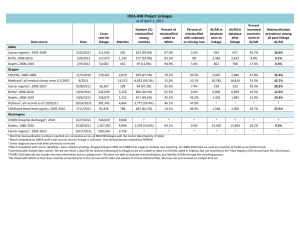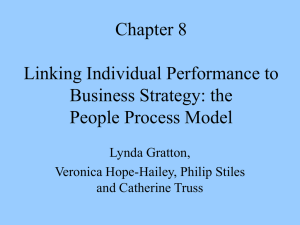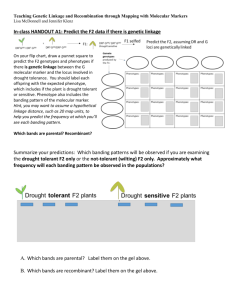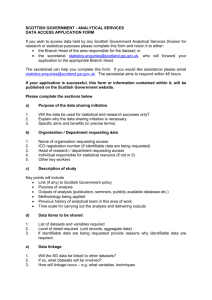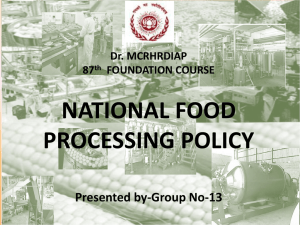Data Sharing and Linkage Service
advertisement
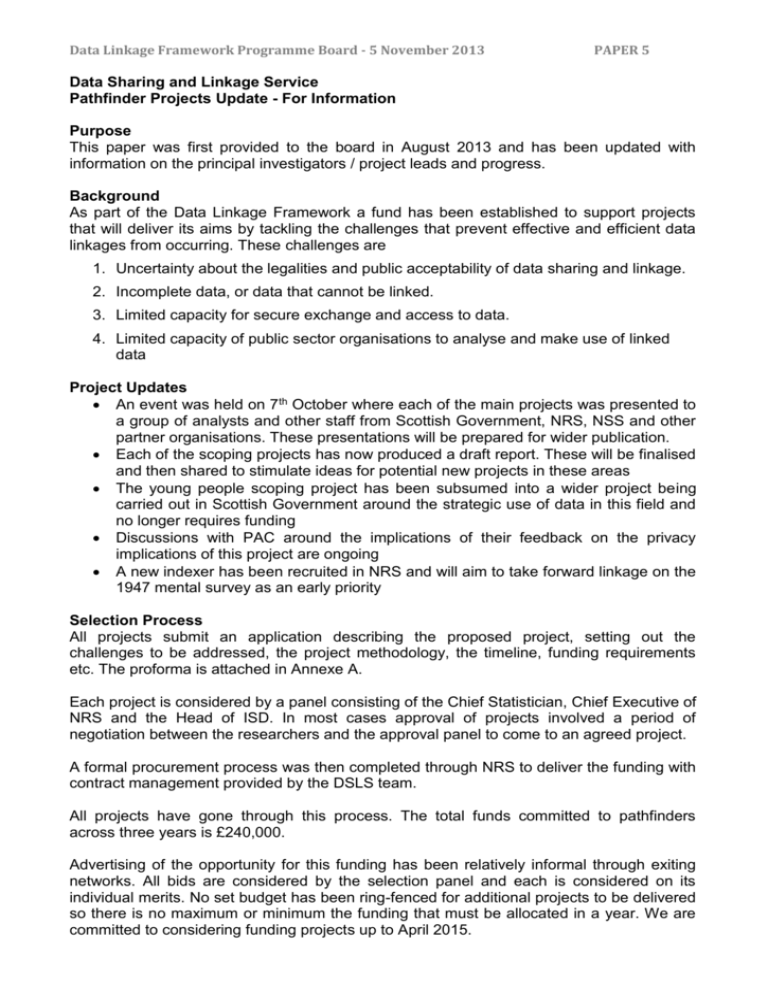
Data Linkage Framework Programme Board - 5 November 2013 PAPER 5 Data Sharing and Linkage Service Pathfinder Projects Update - For Information Purpose This paper was first provided to the board in August 2013 and has been updated with information on the principal investigators / project leads and progress. Background As part of the Data Linkage Framework a fund has been established to support projects that will deliver its aims by tackling the challenges that prevent effective and efficient data linkages from occurring. These challenges are 1. Uncertainty about the legalities and public acceptability of data sharing and linkage. 2. Incomplete data, or data that cannot be linked. 3. Limited capacity for secure exchange and access to data. 4. Limited capacity of public sector organisations to analyse and make use of linked data Project Updates An event was held on 7th October where each of the main projects was presented to a group of analysts and other staff from Scottish Government, NRS, NSS and other partner organisations. These presentations will be prepared for wider publication. Each of the scoping projects has now produced a draft report. These will be finalised and then shared to stimulate ideas for potential new projects in these areas The young people scoping project has been subsumed into a wider project being carried out in Scottish Government around the strategic use of data in this field and no longer requires funding Discussions with PAC around the implications of their feedback on the privacy implications of this project are ongoing A new indexer has been recruited in NRS and will aim to take forward linkage on the 1947 mental survey as an early priority Selection Process All projects submit an application describing the proposed project, setting out the challenges to be addressed, the project methodology, the timeline, funding requirements etc. The proforma is attached in Annexe A. Each project is considered by a panel consisting of the Chief Statistician, Chief Executive of NRS and the Head of ISD. In most cases approval of projects involved a period of negotiation between the researchers and the approval panel to come to an agreed project. A formal procurement process was then completed through NRS to deliver the funding with contract management provided by the DSLS team. All projects have gone through this process. The total funds committed to pathfinders across three years is £240,000. Advertising of the opportunity for this funding has been relatively informal through exiting networks. All bids are considered by the selection panel and each is considered on its individual merits. No set budget has been ring-fenced for additional projects to be delivered so there is no maximum or minimum the funding that must be allocated in a year. We are committed to considering funding projects up to April 2015. Data Linkage Framework Programme Board - 5 November 2013 PAPER 5 Projects Project: NHS Greater Glasgow and Clyde Population Counts Aim: To enable a better understanding of the differences in population counts produced by different sources for Glasgow City Council and NHS Greater Glasgow and Clyde Project Lead / Principal Investigator: Kirsty MacLachlan NRS Objectives: to provide a better understanding of the differences between population estimates in Scotland calculated by NRS (the Census and the Mid-YearEstimates) and estimates derived from administrative data sources, such as the CHI, NHSCR, Local Authority (LA) data, etc. to review and document available data sources and assess whether the data quality of administrative data sources can be improved to establish the suitability and accuracy of relevant data sources and determine whether it is possible to use them to contribute to population statistics to assess whether the population of NHS service users in GG&C Health Board area is significantly different to the population estimates produced by NRS, particularly given the significance of the MYE in determining the allocation of NHS resources to identify any potential disparities in the population estimates for particular geographical areas or subsets of the population, with the intention of documenting, explaining and assessing the implications of these differences where possible. To report on any barriers to data sharing that are identified and to document the steps taken to reduce or alleviate these barriers. This will assist the work that is taking place in the Beyond 2011 programme and the Data Sharing & Linkage Service (DSLS). Costs: £70,000 (to provide staff in NRS) plus potential support in kind for linkage when DSLS staff in place Outcomes: to create an inventory of all relevant administrative data sources, including an assessment of the potential contribution each dataset can make to the project objectives. to produce detailed reports which describe and analyse the differences between the various datasets to which access is granted, including summary tables of population estimates from different sources. to create a set of agreed population records which enable a reliable and accurate population estimate to be derived. to report and present any recommendations concerning the future allocation of NHS funding to TAGRA based on the evidence found in the analysis. Data Linkage Framework Programme Board - 5 November 2013 PAPER 5 to report on any barriers to data sharing that are identified and to document the steps taken to reduce or alleviate these barriers and to inform the development of the population spine This will assist the work that is taking place in the Beyond 2011 programme and the Data Sharing & Linkage Service (DSLS). Learning Points Data quality The project is particularly focussed on the quality of data used to produce full population statistics and will help to address data quality and completeness issues associated with this type of data. Ensuring the data quality improvement work can be generally applied across local authorities and health boards is an important factor being considered. For example the project has developed our understanding of the challenges associated with identifying the whereabouts of hard to count groups such as young men not in regular contact with health or authority services Data sharing This project is developing our understanding on all the challenges by investigating sharing and linking issues relating to data held by the council, the health board, NRS and ISD as well as other potential sources of population data. Spine The project is informing the development of the population spine to be used both in Beyond 2011 and to facilitate linking in the DSLS Technicalities of linking and sharing The project gives an opportunity to test and develop our technical approaches to file exchange, linkage etc Timescales Key Milestones By Jan 2014 – Source investigation phase complete, aiming to have data access in place By March 2014 – Inventory of data sources completed By April 2014 – Report on Barriers encountered to sharing By Jan 2015 – Expansion to support national level work for B2011 By Jan 2015 – Further record level linkage in support of B2011 complete Data Linkage Framework Programme Board - 5 November 2013 PAPER 5 Project: Children vulnerable to maltreatment and/or neglect: scoping the capacity of the Scottish Longitudinal Survey (SLS) to address research questions of interest. Project Lead / Principal Investigator: Janice McGhee, Edinburgh University Aims: To scope whether it is possible to identify vulnerable children using the SLS through mapping relevant information within its linked administrative and health-related data. To explore whether data in the SLS would be useful and/or possible in creating task specific administrative data linkage projects addressing research questions relevant to these children To explore, given privacy and data issues, whether the SLS may be a suitable vehicle to conduct longitudinal research on children who potentially may be vulnerable to maltreatment and/or neglect in Scotland. Objectives: To identify and create indicators from relevant variables/field within SLS and linked administrative and health-related data that could potentially identify populations of children who may be vulnerable to maltreatment and neglect. This would include discussion of relevant derived variables (such as key hospital admission codes). To identify and create indicators from relevant variables/field within SLS and linked administrative and health-related data that may have the capacity to answer specific questions about children who potentially may be vulnerable to neglect and abuse. To gather information on frequencies, for example, the number of parents in treatment for drug misuse who also have children. To identify appropriate sample(s) from the SLS. Taking account of privacy issues this may include identifying vulnerable children born to SLS members who are the parents, or SLS members who are children and linking in information on their mother. After identifying the sample(s), to explore whether there would be sufficient numbers for useful longitudinal analysis? To explore technically as to whether either a SLS member who is the child can have other family records linked (health data about their parents), in order to provide informative longitudinal data about vulnerable children and their parents. For example, are the datasets CHI seeded, or hold other appropriate identifiers, in order to have required information for the linkage to the SLS. Further, to explore ethical issues in consultation with the NHS/ISD Privacy Advisory Committee (PAC) relevant to linkage beyond the SLS member, either as the child or parent, since this will be required to track development and vulnerability To identify new linkages from current health and social care datasets that would be necessary to, or would enhance, the identification and tracking of these vulnerable children. Data Linkage Framework Programme Board - 5 November 2013 PAPER 5 Costs: £25,000 Outcomes: The primary outcome would be a working paper scoping the capacity of the Scottish Longitudinal Survey and associated health and education related databases to identify children who may potentially be vulnerable to maltreatment and/or neglect. This would include: Discussion of practical, ethical and technical issues in linking data; Exploration of the possibility of small scale linkages that would be informative about specific aspects of children’s well-being, for example, child members who are in treatment for substance misuse and who have children; Potential research questions that could be addressed; and Whether there is likely to be sufficient numbers of relevant children for any longitudinal analysis. The secondary outcome would be a paper to discuss the implications arising from the identified practical, ethical and technical issues in the context of the proposed National Data Linkage Centre and PAC regime. Learning Points Consent Explore issues relating to consent where data on another un-consented individual (e.g. a parent) is required in order to study an individual where consent does exist (e.g. the child) Issue associated with very small population Inform us on how to use data linkage to create longitudinal research to facilitate the study of very small population groups (such as vulnerable children) and inform us on any particular privacy issues due to the small populations Read Through Informing the work on maintaining the ability to link between admin systems for this purpose Approvals Will work through existing approval processes as well as using new streamlined processes gathering valuable experience and insights into the mechanisms around this to inform the programme NB This project has recently received feedback from its PAC application. It has identified a number of significant issues relating the privacy of the individuals involved. Given the vulnerable nature of the individuals involved the PAC felt there was an obligation to act if the researcher identified a potential for harm to an individual (even if this was a deidentified record) and that this would potentially result in a breach of privacy. Researchers at Edinburgh University and the SLS are currently clarifying and responding to the PAC feedback and colleagues from Scottish Government and NRS will also contribute to understanding the PAC response and developing a way forward to deal with the important issues that have been identified for this project. This may result in a change in the timeline and scope of this project but it is providing exceptionally valuable learning Data Linkage Framework Programme Board - 5 November 2013 PAPER 5 around the nature of analysis of vulnerable individuals and small populations. 25/10/13 – Discussions with PAC are ongoing but have not yet been concluded to allow the project to be replanned Timescales Key Milestones - Initiation - December 2012 - Review of Variables - February 2013 - Completion of PAC application - March 2013 - Completion of analysis report – October 2014 Data Linkage Framework Programme Board - 5 November 2013 PAPER 5 Project: Looked After Children Data / Dental Records Project Lead / Principal Investigator: David Conway, University of Glasgow Aims: A data linkage study which provides access to population wide data from NHS dental and local authority sources. These will provide greater scope for comparison between young people who are looked after by the state and their peers. Finally we aim to set out the governance and technical protocols which can be used in future projects which to link the similar data sets Objectives: To conduct a cross-sectoral data linkage project focusing on linking and analysing the NHS dental service and oral health data collated in the Information Services Division (ISD) of National Services Scotland (NSS) to the national data on looked after children collected by local authorities and collated by the Scottish Government. This will include a comparison of oral health and access to dental services among looked after children with the wider child health population and assess any variation by geographic location, age, sex, and category of looked after children. To provide guidance which will facilitate data linkage in the longer-term and thus the sustainability of the project. To provide results to inform the development of care pathways for these children within the Childsmile national oral health improvement programme. This will include producing a report for the Childsmile Board and Chief Dental Officer, Scottish Government to inform the development of care pathways into dental services for looked after children Costs: £110,000 Outcomes: 1) Produce a protocol for cross-sectoral record-linkage involving health and Looked After Children data. This will include detailing governance processes in relation to approval for data access, linkage and analysis. It will also include outlining a mechanism for maintaining the potential for future linkage without the maintenance of a large merged database (read through) 2) Produce a detailed metadata report of linked dataset including variable descriptors and definitions, and data quality, completeness, accuracy (with detailed focus on LAC data). 3) Produce a final research report on the findings of the data linkage detailed epidemiological analysis and draft papers for peer reviewed journals. These publications will include explanations for these findings, demonstrate the utility of this cross-sectoral linkage, and explore the need for developing potential interventions and care-pathways for these children. Implications for general health outcomes and services will also be explored Learning Points Approvals and Sharing: Our study will continue to explore the information governance and approval processes for cross-sectoral linkage building on learning from the Scottish Informatics Programme (SHIP) and on the first ScotXed and health linkage of SCN and CHI numbers. Permission will be sought from the ScotXed and LAC data access controllers / committees. NHS ethics approval is unlikely to be required for the data linkage, but a NHS Data Linkage Framework Programme Board - 5 November 2013 PAPER 5 Ethics Committee scientific officer will be consulted for advice. Data Quality: Our project will also include assessment of quality and completeness of the LAC dataset. Read Through: The project will be an exemplar for read through and seek to establish the principle and process of read through by establishing this between health and education Cross sectoral working: We believe our collaboration of multi-disciplinary academics with colleagues in ISD, and Scottish Government with strong policy and front-line service links, will deliver the additional capacity to analyse and support the use of linked data. The techniques developed by our project are likely apply to other preventive health services for children who are looked after by the state including for example, immunisation programmes, sexual health initiatives and other interventions which seek to improve health and wellbeing. End to End Linkage Project: This project allows us to test from beginning to end the proposed processes being developed to deliver data linkage from initiation, approvals, sharing, linkage, analysis and disclosure control. Contribution to Official Statistics: It is intended that the linkage between LAC and health will ultimately contribute to LAC national statistics reporting so this project will help us to identify particular issues relating to production of national statistics that can be more widely applied. Timescales Key Milestones Project Initiation - January 2013 Data Sharing Agreement for LAC data - March 2013 Source Metadata Report - November 2013 All remaining health approvals and pathway protocol - November 2013 Final generic read through process - January 2014 Interim Linking and Analysis Report - February 2014 Final Linking and Analysis Report - March 2014 Linked Metadata Report - June 2014 Final Research Report - September 2014 Data Linkage Framework Programme Board - 5 November 2013 PAPER 5 Project: Data Quality Improvement in Scottish Environmental Protection Agency (SEPA) Project Lead / Principal Investigator: Duncan Taylor / Steven Fox (SEPA) Aims: To start rolling out within a test setting ProcXed, the ScotXed data validation tool, to demonstrate that it can be delivered outwith the existing Scottish Government limitation to deliver improved data quality in partner organisations Objectives: To demonstrate the de-coupled ProcXed tool can be used externally in test and then in the live installation To test this within a near live environment To understand user issues associated with using the tool externally To understand challenges and opportunities associated with this approach To add additional users organisations based on the experience with SEPA Costs: No cash cost but in kind support being provided by Scotxed Outcomes: SEPA to use ProcXed to collect data from a range of partners to feed into their Aquaculture project using an automated upload, validation and data transfer process to move the data into their backend systems to support reporting etc. To demonstrate the usefulness of the tool in a live data collection / improvement environment by delivery of case studies describing the process Improved data quality / collection in partner organisations To open up potential access to new data sources Learning Points Data Quality To help understand the issues around improving data quality within a live collection environment Service Provision To help understand the challenges and opportunities associated with providing a service to partner organisations around data quality improvement and to provide technical feedback on the provision of the validation tool. NB Following on from this project ScotXed are also now working with Building Standards – this is a collection that will go live in early 2014 and have gone live with data collection on the first benefit to be administered in Scotland – Scottish Welfare Fund. Lessons learned from this project have contributed to successful deliver of these follow on projects and the improved quality data already being collected Timescales Key Milestones Test set up established and SLA agreed - February 2013 Data Collections started - March 2013 Data Linkage Framework Programme Board - 5 November 2013 Final technical set up work completed - August 2013 Live processes started - September 2013 Aquaculture website live – October 2013 Evaluation complete – November 2013 PAPER 5 Data Linkage Framework Programme Board - 5 November 2013 PAPER 5 Project: Cross-Sectoral Scoping Opportunities and Challenges Aims: To start focussing on specific challenges and opportunities associated with linking of data between specific sectors Project Lead / Principal Investigator: Health – Jill Pell, University of Glasgow; Environment – Marian Scott, University of Glasgow; Genetics – Pamela Linkstead, Generation Scotland; Young People – Carrie Graham, Scottish Government Objectives: Develop our network of researchers interested in data linkage For a number of important sectors identify; o any current sector level key policy drivers or challenges that could be better addressed with improved evidence or research using linked data and any key / priority opportunities to link datasets to help deliver this improved evidence from the perspective of those within the sector o The challenges preventing this from happening (eg legal, data quality etc) o Any current data linkage centres, infrastructure or resource within the sector At the dataset level identify; o Important datasets within the sector including a brief summary explanation of what is held in the dataset, coverage eg national or for a specific location, type of data eg survey or census data, administrative data, purpose of collection eg for statistics, for administration etc, and how often the data is collected or updated eg annual collection, constantly changing admin system o Specific useful linkages that could be made to this data set o Benefits of making this linkage o Barriers to creating this linkage Costs: £30,000 (across four partners - Environment, Health, Genetics and Young People) Outcomes: Increase our network of interested researchers to be further developed Meta data on each of the identified sectors Priority projects within and between sectors Increase visibility and recognition of the DLF Initial projects to be delivered through DSLS Learning Points Challenges and Opportunities Increase our knowledge by gathering detailed information on the range of challenges and opportunities presenting within specific sectors, increasing the detail of our knowledge on specifics within sectors Expectation of Researchers Increase our knowledge of what specific researchers expect to be able to deliver in terms of linked data and what they expect of a linkage service being developed to deliver this Prioritisation of Linkage Can we start to identify a key strategic core of datasets that will Data Linkage Framework Programme Board - 5 November 2013 PAPER 5 open up linkage across a number of sectors and so should be prioritised for linkage Timescales Key Milestones Health Scoping August 2013 Environmental Work Completed September 2013 Genetics Work Completed October 2013 Young People Completed January 2014 Data Linkage Framework Programme Board - 5 November 2013 PAPER 5 Project: 1947 Mental Survey Linkage Project Lead / Principal Investigator: Ian Deary, Edinburgh University Aims: To develop a new longitudinal linkage resource based on the 1947 national survey of the mental ability of 11 year olds by linking to the NHSCR to allow records to be linked up to the present and back to the 1939 population register Objectives: To identify broader issues and opportunities for longitudinal research and opportunities to link to the 1947 data To link the 1947, 1939 and NHSCR To agree a storage strategy for this new resource Costs: £10,000 Outcomes: Linked data set matching all elements of the 1947 data (main population plus detailed sub-samples) to NHSCR Scoping report on longitudinal data Scoping report on linking to the 1947 data Agreed storage solution for this dataset Learning Points Longitudinal Data Longitudinal data projects are long term and so require data storage solutions not required more broadly as linked data projects within the framework will not be maintained beyond the end of the particular project Technicalities of Linkage This project will be used as a training tool for new indexing staff Permissions and Approvals This project will require PAC approval and will also help develop our understanding of consent etc around longitudinal data Capacity This project has been used to inform assumption on technical capacity required to deliver linkage projects Timescales Key Milestones Initiation - May 13 General Scoping paper – October 13 Data linkage work complete - May 14 Storage solution in place – May 14 Data Linkage Framework Programme Board - 5 November 2013 PAPER 5 Annex A: DATA LINKAGE FRAMEWORK FUNDING BID TEMPLATE Funding is available until April 2015 to support projects that will help deliver the aims of the Scotland-wide Data Linkage Framework for statistical and research purposes by tackling the challenges that prevent more effective and efficient data linkages from occurring in Scotland. These challenges are: o Uncertainty about the legalities and public acceptability of data sharing and linkage. o Incomplete data, or data that cannot be linked. o Limited capacity for secure exchange and access to data. o Limited capacity of public sector organisations to analyse and make use of linked data. For further information on the framework and a fuller explanation of the challenges see http://www.scotland.gov.uk/Topics/Statistics/datalinkageframework Funding of up to £250,000 is available. There is no minimum bid. Funding will only be provided to projects that offer good value for money in tackling at least one recognised challenge to effective data linkage. Projects that will have a long-term impact on the capacity for data linkage in Scotland will be favoured. Please note that this may include projects that involve data linkage directly if they can be shown to provide proof of concept or pave the way for further development, but projects do not have to involve data linkage directly. For example, projects to consider legislative or ethical issues, develop analytical capacity for use of already linked data, or improvements to data collection systems to allow for future data linkage will all be considered. Projects that can synergise effectively with other elements of the data linkage programme plan will be favoured, as will projects that involve or may support development of crosssectoral linkages (e.g. health-justice-housing or education-environment, rather than linkages within a sector). Bids will be assessed on the extent to which they offer value for money in tackling the challenges that prevent more effective and efficient data linkages from occurring in Scotland. There is no annual deadline for bids, but early bids or early indication of interest would be very much appreciated. To discuss potential bids at any stage please contact Gerry Donnelly 0131 314 4312, gerald.donnelly@scotland.gsi.gov.uk . We will be happy to work with you in developing your proposal and aligning it with wider framework developments if feasible and appropriate. As a rough guide, no answer should be more than 500 words. No minimum. Further detail will be requested if necessary, and a full research specification and/or a meeting to discuss details may be required subsequent to this initial bid. Data Linkage Framework Programme Board - 5 November 2013 PAPER 5 1. Contact name, organisation, phone number, email address 2. Brief overview of rationale, aim and objectives of the project To enable a better understanding of the differences between population counts in the different data sources (Community Health Index (CHI), NHS Central Register (NHSCR), Census, Council data etc) for NHS GGC and Glasgow Council. 3. Which challenge(s) to better data linkage in Scotland will this project help to tackle (check box(es)) Uncertainty about the legalities and public acceptability of data sharing and linkage Incomplete data, or data that cannot be linked Limited capacity for secure exchange and access to data Limited capacity of public sector organisations to analyse and make use of linked data Briefly explain how the project will tackle this challenge (if not already covered in question 2). 3. Which National Outcome(s) will the project contribute to? 4. Proposed methodology (if the project is to link data, include which datasets will be used, information about if/when/how ethical and access permissions will be sought, and pilot work) 5. Funding required and top level breakdown of costs (e.g. year, staff, consultancy, infrastructure) 6. Outline of project timetable (including key milestones) Data Linkage Framework Programme Board - 5 November 2013 PAPER 5 7. Outline key deliverables (outputs) 8. Briefly outline main risks, their likelihood and impact and how they will be mitigated 9. Explain if, how and when outputs, insights and lessons learned from this project will be shared with others 10. If this project fits with any related programmes, existing or planned funding streams, please explain how



